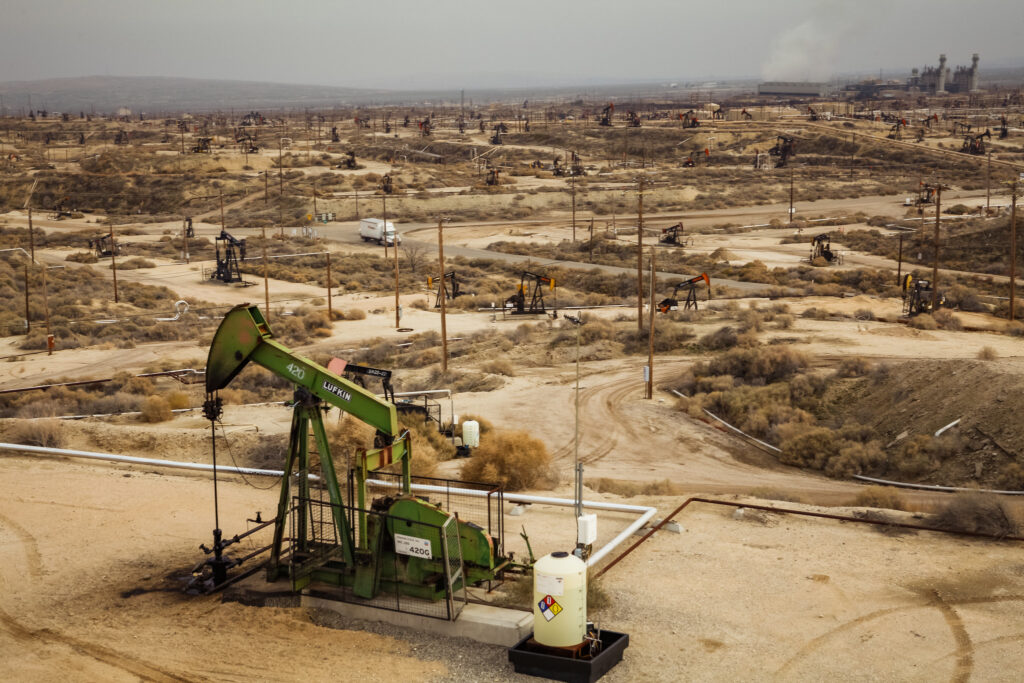Last month, the California Resources Corporation (CRC), already the largest gas producer in the Golden State, announced a plan to get even bigger: It would acquire competitor Aera Energy, California’s second-largest oil producer behind Chevron. Both companies already operate thousands of extraction sites in California, and their successful merger would make CRC the state’s largest oil and gas producer by an overwhelming margin.
At a time when the U.S. oil and gas industry is rapidly consolidating in an effort to unlock new economies of scale, investors took the merger’s announcement as a positive development and CRC’s stock price jumped. But what has received much less attention so far is the fact that this merger likely will put to the test a new state law that aims to hold oil and gas producers accountable for idle wells, sites that haven’t been used for production for 24 consecutive months.
If successful, the merger would make CRC by far the state’s largest holder of idle oil and gas wells, which can pose ongoing environmental hazards, often continuing to leak methane and other pollutants like benzene and lead. Today, CRC and Aera are responsible for more than 15,000 of the state’s roughly 40,000 idle wells, according to data from California’s Geologic Energy Management Division (CalGEM). The merger would put California in uncharted territory, placing 40 percent of the state’s idle wells under the control of a single entity.
“The big risk here is that the merger between Aera and CRC would create an operator that is too big to fail,” said Kyle Ferrar, western program director at FracTracker Alliance, a nonprofit that analyzes data on oil and gas development hazards. If it did fail, he said, and if California were then forced to bear the cost of plugging all of those wells on its own, “the consequences for the state’s budget would be immense.”
It costs about $111,000 on average to decommission a well in California, according to CalGEM, an obligation that typically falls to the state when companies can’t pay. But California recently took action to keep industry on the hook: AB 1167, which was signed into law in October, requires companies to issue a bond big enough to cover the full cost of closing down any low-producing wells they acquire, including idle wells. The new rules went into effect on Jan 1, and CRC’s merger with Aera would seem to fall squarely within their scope.
“The state of California must immediately jump in before allowing this transaction to be final and require California Resources to put up the hundreds of millions of dollars in bonding needed to acquire Aera’s wells so that consumers are not left holding the bag on their eventual plugging,” said Liza Tucker, a consumer advocate with the nonprofit public advocacy group Consumer Watchdog, in a press release responding to news of the deal.
Jasmine Vazin, a senior campaign officer at the Sierra Club who recently co-authored a report on the looming expense of idle well cleanup in California, said she feared the cost of shutting down tens of thousands of wells could be more than a company like CRC can sustain. The fact that CRC emerged from bankruptcy just three years ago, she said, raises questions about how prepared it is “to be taking on such a huge liability for cleanup.”
A DeSmog analysis of data provided by FracTracker Alliance found that AB 1167 should trigger a bonding requirement even larger than what has been publicly discussed: Over $1 billion, a historic amount that would give California much more security while it waits for Aera to close its thousands of idle (and soon-to-be idle) wells. But the new law has only been on the books for a few months, and it hasn’t been enforced before. CalGEM, the division of California’s Department of Conservation responsible for reviewing the merger, has not yet signaled whether it will apply the new law to CRC’s attempt to buy Aera, despite mounting questions. And some advocates are already expressing concern about how this first test of AB 1167 will play out.

A Billion-Dollar Bond
For decades, the law has been clear: Oil and gas producers are required to close down their defunct wells in California. But full remediation — which includes plugging deep boreholes with concrete and fully decommissioning all above-ground equipment — is incredibly expensive, and companies have long found ways to avoid it.
Even under ideal circumstances, decommissioning costs stack up quickly. CalGEM estimates that it costs $87,000 to shutter a well in what it calls the Central district, which is made up of four inland counties west of the Sierra Nevada mountains (Fresno, Kern, Kings, and Tulare), and includes the sprawling oil-producing regions near Bakersfield. The process is much more expensive elsewhere in the state. In a recent earnings call, CRC CEO Francisco Leon said the company had spent $2 million to shut down six wells and related infrastructure. CalGEM estimates that the cost for closing down a single well in California’s population-dense southern district — which includes Los Angeles, San Diego, and Orange counties — is close to $1 million.
Operators often buckle under the weight of this obligation. There are currently 5,000 “orphan” wells, or idle wells without a financially solvent operator, in California, according to a Sierra Club analysis of CalGEM data. When that happens, taxpayers end up footing the bill. California budgeted $100 million over the past two years for plugging wells that companies should have closed down, but didn’t.
Though the state has long required operators to bond their wells as a form of financial assurance, a “blanket bond” provision has allowed companies to meet their obligation at a fraction of the cost. Industry lobbied aggressively to put these permissive rules in place, as DeSmog has previously reported. For comparison, California currently holds only a $3 million bond for Aera — which would give the state just a few hundred dollars per well to work with if Aera ever became insolvent.
Lawmakers passed AB 1167 to address this situation, helping to prevent aging wells from transferring into the hands of entities that can’t afford to close them. Under the new rules, which took effect January 1, any company that takes control of a well producing less than 15 barrels of oil or 60,000 cubic feet of natural gas per day must file a bond with the state large enough to cover the full amount of plugging, decommissioning, and site restoration. In a major shift, there is no blanket exemption; each individual well must be bonded at an amount equal to the full cost of its remediation. That requirement provides California with a strong financial guarantee — one environmental advocacy groups say is urgently needed in the case of CRC’s merger with Aera.
“This is a consolidation of a really large number of wells in the hands of one operator,” said Ann Alexander, director of energy solutions at the Natural Resources Defense Council. “The proposal is to put a whole lot of eggs in the CRC basket. That creates a risk.”
CRC’s merger with Aera stands to be the first major merger and acquisition activity since AB 1167 took effect, and Alexander, who helped to craft the language in the bill and lobbied for its passage, insisted that the new rules would be relevant. “From all appearances to us, this is a situation where 1167 is intended to and does apply,” she said. Hollin Kretzmann, a legal analyst for the Center for Biological Diversity, agreed, writing by email that he was confident the merger would trigger the individual bonding requirement.
Any straightforward application of the rules would have huge implications, given the sheer number of wells that stand to change hands. CalGEM data pulled by FracTracker Alliance and provided to DeSmog for analysis showed that a huge number of Aera wells would require bonding in the event of a merger: nearly 15,000 were idle or produced less than 15 barrels per day in 2022. By applying CalGEM’s standard cost estimates per district, DeSmog found it would cost over $1.3 billion to plug all those wells.
Full CalGEM data for 2023 is not yet available. But it appears that any bonding mandate triggered by CRC’s merger with Aera should be well over a billion dollars, even assuming that Aera has closed hundreds of wells since 2022. In a January 25 email, Aera spokesperson Kimberly Ellis told DeSmog that it had planned to close 950 wells in 2023, though she declined to say if that goal had been achieved. Even if Aera managed to exceed its goal and close 1,000 wells last year, it would only have lowered the overall bonding requirement by about $90 million to approximately $1.2 billion.
For context, CRC reported about $400 million in free cash flow in 2023. A $1.2 billion bond — a big sum, even for an oil company — could easily tie up three years’ profit. Aera’s entire operation was only valued at $2.1 billion under the terms of the proposed merger.
DeSmog sent detailed questions to both California Resources Corporation and Aera Energy. Aera Energy declined to comment and California Resources Corporation did not respond by press time.
“The staggering cost to plug and abandon these wells is exactly why we pushed for AB 1167,” Alexander said. “It created a means to make sure that cost doesn’t land on taxpayers after a transfer. Now we just need CalGEM to enforce it.”

“No evidence the law has been complied with yet”
As California enters a new era of flagging production and more stringent regulations — what Reuters has called “the end of an era” — the question of who will pay to close down spent wells has taken on new urgency. All of the state’s oil wells will need to be closed eventually, which will cost between $13.2 to $21.5 billion, according to a 2023 Carbon Tracker report. The same report found that extracting every drop of oil left in California would only generate about $6 billion in revenues for the state’s oil industry, proof that liabilities are quickly outpacing profits. That’s left some concerned that the industry won’t clean up its mess because it simply can’t afford to.
“It would be pure fantasy to expect California’s oil industry, whose in-state production peaked in the 1980s and has been declining for years, to voluntarily fulfill all of its cleanup obligations, because it won’t even make enough money to pay for it,” the Los Angeles Times’ editorial board wrote in 2023. “Without swift and dramatic changes, much of the cleanup costs will fall to taxpayers.”
A billion-dollar bond for Aera’s wells would be a huge boon for California as it struggles to rein in rising costs related to well cleanup. Though CalGEM has been allowed to obtain a maximum $30 million blanket bond from the state’s largest operators since 2019, that amount comes nowhere close to covering the full cost of cleanup. Until recently, it had declined to seek even the full $30 million, letting the state’s largest of owners of idle wells — Chevron, Aera, and CRC — skate by with bonds of just $3 million each.
That changed on December 19, less than two months before the merger was announced, when CalGEM quietly obtained the maximum $30 million bond from CRC. It was a historic amount for an oil and gas company to put up, but it still comes nowhere close to covering the risk from CRC’s thousands of idle wells — let alone from the Aera wells it plans to acquire. It’s not yet clear if CalGEM’s decision to raise CRC’s bond was related to the pending merger.
If the merger is allowed to go through, and CRC provides California with a bond big enough to cover the full cost of closing Aera’s wells, it would be a significant step toward de-risking the oil industry’s liabilities in the state. And yet Alexander expressed concern that the rules so far weren’t playing out as intended.
“We have no evidence that the law has been complied with yet,” she said. She explained that CalGEM will need to do an assessment to determine the bonding obligation before the merger can go through, and that CalGEM is required by law to post information about its determination online. As of this writing, that still hasn’t happened.
On February 16, Alexander and signatories from 13 other advocacy groups wrote to newly appointed CalGEM supervisor Doug Ito — who has a background in consumer protection and public health oversight — to inquire about how the agency intends to apply the new rules.
“We are eager to track compliance, since AB 1167 was a critical priority for the environmental community last year, which we view as a bulwark against the risks inherent in transfers of low-producing wells,” they wrote.
CalGEM responded to the letter by hosting a meeting on Friday, March 15. Alexander and two staffers from the environmental lobbying nonprofit Environment California met with attendees, including Ito and CalDOC Director David Shabazian. According to Alexander, the state officials said CalGEM had no information yet to suggest that provisions passed under AB 1167 would apply to this merger, but that a conclusive determination can’t be made until the deal is finalized.
Several experts interviewed for this story felt that the language of the law — which is broadly written to include any entity who “acquires the right to operate a well or production facility, by purchase, transfer, assignment, conveyance, exchange, or other disposition” — was clear-cut, and were mystified by CalGEM’s reluctance to make a determination.
“The law regulates the transfer not between operators, but who has control and management of those operators,” said Ferrar, of FracTracker Alliance. Any merger, in other words, would give CRC the legal right to operate Aera’s wells — no matter how their day-to-day management is structured under the terms of the deal.
But when DeSmog reached Jacob Roper, assistant director of public affairs and communications for the California Department of Conservation (CalDOC), by phone on February 26, he could share no information about how AB 1167 would be enforced. In response to follow-up questions sent by email, Roper said that “the Department of Conservation is aware of the pending stock transaction between the two companies.” Roper also noted that it had issued guidance around compliance to industry in December.
Despite CalGEM’s noncommittal stance, Alexander remained hopeful that the law would be applied as intended.
“We have to put some kind of brakes on this slow-moving crisis, and we are now presented with a very significant opportunity to do that, assuming that we’re all reading correctly what has happened in this transaction,” she said, adding that the health and financial costs of inaction could be “potentially catastrophic.”
Vazin, of the Sierra Club, also expressed a mix of disappointment and optimism.
“This is par for the course for our work with CalGEM. I think the agency has a long way to go to meet the standards of its own mandates when it comes to informing the public and being more transparent about what’s going on behind closed doors,” she said. “We’re hoping, with the new supervisor in place, that CalGEM can show up differently and be an agency that does have transparency with the public. And we’re hoping we get the answers we’re looking for sooner than later.”
Subscribe to our newsletter
Stay up to date with DeSmog news and alerts







